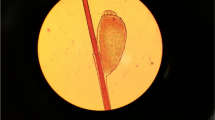Abstract
In the appraisal of head lice outbreak, in addition to socioeconomic factors and availability of health care services, environmental conditions of the households must be taken into account. However, interviewing with children or mailing questionnaires to families may not reflect the actualities. Therefore, in this study, all the inclusive factors which may be associated with head lice outbreak were thoroughly and closely investigated. The data were collected by examining students at schools and surveying patients’ households. A questionnaire concerning children’s personal hygienic practices, family features, and environmental conditions of the households was filled out during the close assessment of the residential area. The overall prevalence of head lice was obtained as 5.9 %, and the difference was not significant within the urban (5.1 %) and rural (6.1 %) communities. Overall, the number of infested students was more frequent in girls (6.6 %) than boys (2.8 %), but the difference was not significant. The highest infestation rate was obtained in the examined students whose fathers were unemployed, farmer, and herdsman. Family income showed greater correlation with the prevalence of pediculosis capitis. A high frequency of pediculosis capitis was identified among the students who were sharing individual items with siblings. Assessment of households showed that room flooring material and keeping animals at home were highly correlated with head lice prevalence. Households should be informed that infestations happen, irrespective of socioeconomic status. However, the physical and environmental conditions of living areas and households play an important role in head lice prevention.
Similar content being viewed by others
References
Abdel-Ghaffar F, Semmler M, Al-Rasheid K, Klimpel S, Mehlhorn H (2010) Efficacy of a grapefruit extract on head lice: a clinical trial. Parasitol Res 106:445–9
Abdel-Ghaffar F, Al-Quraishy S, Al-Rasheid KA, Mehlhorn H (2012) Efficacy of a single treatment of head lice with a neem seed extract: an in vivo and in vitro study on nits and motile stages. Parasitol Res 110:277–80
Afshari A, Gholami M, Haghverdi T, Haj-Bagheri S (2013) Study of prevalence of head lice infestation in female students in primary schools in Robat Karim county during 2008–2009 years. Yazd Faculty of Health Journal [In Persian] 12:102–12
Al-Quraishy S, Abdel-Ghaffar F, Mehlhorn H (2015) Head louse control by suffocation due to blocking their oxygen uptake. Parasitol Res 114:1–6
Billstein S, Laone P (1979) Demographic study of head lice infestations in Sacramento County school children. Int J Dermatol 18:301–4
Burgess IF (2004) Human lice and their control. Annu Rev Entomol 49:457–81
Burgess IF (2009) Current treatments for pediculosis capitis. Curr Opin Infect Dis 22:131–6
Centers for Disease Control and Prevention (2010) Parasites: head lice
Chouela E, Abeldano A, Cirigliano M, Ducard M, Neglia V, Forgia ML, Colombo A (1997) Head louse infestations: epidemiologic survey and treatment evaluation in Argentinian schoolchildren. Int J Dermatol 36:819–25
Chunge RN, Scott FE, Underwood JE, Zavarella KJ (1991) A pilot study to investigate transmission of headlice. C J Public Health 82:207
Counahan M, Andrews R, Büttner P, Byrnes G, Speare R (2004) Head lice prevalence in primary schools in Victoria, Australia. J Paediatr Child H 40:616–9
Davarpanah MA, Kazerouni AR, Rahmati H, Neirami RN, Bakhtiary H, Sadeghi M (2013) The prevalence of pediculus capitis among the middle schoolchildren in Fars Province, southern Iran. Caspian J Intern Med 4:607
Eisenhower C, Farrington EA (2012) Advancements in the treatment of head lice in pediatrics. J Pediatr Health Car 26:451–61
Falagas ME, Matthaiou DK, Rafailidis PI, Panos G, Pappas G (2008) Worldwide prevalence of head lice. Emerg Infect Dis 14:1493–4
Gallardo A, Cueto GM, Picollo M (2009) Pediculus humanus capitis (head lice) and Pediculus humanus humanus (body lice): response to laboratory temperature and humidity and susceptibility to monoterpenoids. Parasitol Res 105:163–7
Gholami Parizad E, Abedzadeh M (2001) Infestation with head lice and its influencing factors in primary students in Ilam. Ilam University of Medical Journal [In Persian] 8:16–21
Gutiérrez MM, González JW, Stefanazzi N, Serralunga G, Yañez L, Ferrero AA (2012) Prevalence of Pediculus humanus capitis infestation among kindergarten children in Bahía Blanca city, Argentina. Parasitol Res 111:1309–13
Heukelbach J, Wilcke T, Winter B, Feldmeier H (2005) Epidemiology and morbidity of scabies and pediculosis capitis in resource poor communities in Brazil. Brit J Dermatol 153:150–6
Hodjati MH, Mousavi N, Mousavi M (2008) Head lice infestation in school children of a low socioeconomy area of Tabriz city, Iran. Afr J Biotechnol 7:2292–4
Kamiabi F, Nakhaei FH (2005) Prevalence of pediculosis capitis and determination of risk factors in primary-school children in Kerman. East Mediterr Health J 11:988–92
Kim JH et al (2011) Comparison of the humoral and cellular immune responses between body and head lice following bacterial challenge. Insect Biochem Molec 41:332–9
Kittler R, Kayser M, Stoneking M (2003) Molecular evolution of Pediculus humanus and the origin of clothing. Curr Biol 13:1414–7
Mahmud S, Pappas G, Hadden WC (2011) Prevalence of head lice and hygiene practices among women over twelve years of age in Sindh, Balochistan, and North West Frontier Province: National Health Survey of Pakistan, 1990–1994. Parasite Vector 4:1–10
Mehlhorn H, Aspöck H (2008) Encyclopedia of parasitology: AM vol 1. Springer Science & Business Media
Moradi A, Zahirnia A, Alipour A, Eskandari Z (2009) The prevalence of pediculosis capitis in primary school students in Bahar, Hamadan province, Iran. J Res Health Sci 9:45–9
Motovali-Emami M, Aflatoonian MR, Fekri A, Yazdi M (2008) Epidemiological aspects of Pediculosis capitis and treatment evaluation in primary-school children in Iran. Pak J Biol Sci 11:260–4
National Pediculosis Association (1985) Questions and answers: moving toward more effective pediculosis prevention in schools. Progress 1:2–3
Nazari M, Fakoorziba MR, Shobeiri F (2005) Pediculus capitis infestation according to sex and social factors in Hamedan, Iran. Southeast Asian J Trop Med Public Health 37:95–8
Oh J-M et al (2010) Prevalence of pediculosis capitis among Korean children. Parasitol Res 107:1415–9
Pai K et al (1989) The prevalence of head louse infestation among urban and rural children in Korea. Korean J Parasitol 27:271–5
Riabi HRA, Atarodi A (2012) Epidemiological and clinical study of infested cases with pediculus capitis and P. corporis in Khorasan-e-Razavi, Iran. Iran J Parasitol 7:85
Rukke BA, Birkemoe T, Soleng A, Lindstedt HH, Ottesen P (2011) Head lice prevalence among households in Norway: importance of spatial variables and individual and household characteristics. Parasitology-Cambridge 138:1296–304
Rukke BA, Soleng A, Lindstedt HH, Ottesen P, Birkemoe T (2014) Socioeconomic status, family background and other key factors influence the management of head lice in Norway. Parasitol Res 113:1847–61
Salemi JA, Shayeghi N, Zeraati H, Akbarzadeh K, Basseri H, Ebrahimi B, Rafinejad J (2003) Some aspects of head lice infestation in Iranshahr area (southeast of Iran). Iranian J Publ Health 32:60–3
Sayyadi M, Vahabi A, Sayyad S (2013) An epidemiological survey of head louse infestation among primary school children in rural areas of Ravansar County, West of Iran. Life Sci J 10:869–72
Semmler M, Abdel-Ghaffar F, Al-Rasheid K, Klimpel S, Mehlhorn H (2010) Repellency against head lice (Pediculus humanus capitis). Parasitol Res 106:729–31
Shahraki G, Azizi K, Yusefi A, Fararooei M (2001) Prevalence of head lice in primary school students in Yasuj. Yasuj University of Medical Journal [In Persian] 6:22–33
Shayeghi M, Paksa A (2010) Epidemiology of head lice infestation in primary school pupils, in Khajeh city, East Azerbaijan Province, Iran. Iranian J Arthropod Borne Dis 4:42
Soleimani-Ahmadi M (2007) The epidemiological aspect of pediculusis in primary school of Qeshm, South of Iran. J Med Sci 7:299–302
Soultana V, Euthumia P, Antonios M, Angeliki RS (2009) Prevalence of pediculosis capitis among schoolchildren in Greece and risk factors: a questionnaire survey. Pediatr Dermatol 26:701–5
Speare R, Buettner PG (1999) Head lice in pupils of a primary school in Australia and implications for control. Int J Dermatol 38:285–90
Speare R, Thomas G, Cahill C (2002) Head lice are not found on floors in primary school classrooms. Aust NZ J Publ Heal 26:208–11
Toloza A, Vassena C, Gallardo A, González-Audino P, Picollo MI (2009) Epidemiology of Pediculosis capitis in elementary schools of Buenos Aires, Argentina. Parasitol Res 104:1295–8
Vahabi A et al (2012) Prevalence and risk factors of Pediculus (humanus) capitis (Anoplura: Pediculidae), in primary schools in Sanandaj City, Kurdistan Province, Iran. Trop Biomed 29:207–11
Vahabi B, Vahabi A, Gharib A, Sayyadi M, Sayyad S (2013) Prevalence of head louse infestations and factors affecting the rate of infestation among primary schoolchildren in Paveh City, Kermanshah Province, Iran in the years 2009 to 2010. Life Sci J 10:360–4
Veracx A, Raoult D (2012) Biology and genetics of human head and body lice. Trends Parasitol xx:1–9
Willems S, Lapeere H, Haedens N, Pasteels I, Naeyaert J-M, De Maeseneer J (2005) The importance of socio-economic status and individual characteristics on the prevalence of head lice in schoolchildren. Eur J Dermatol 15:387–92
Yousefi S, Shamsipoor F, Abadi YS (2012) Epidemiological study of head louse (Pediculus humanus capitis) infestation among primary school students in rural areas of Sirjan County, south of Iran. Thrita J Med Sci 1:53–6
Acknowledgments
This study is a part of an MSc thesis by Shahin Salimian in Environmental Health Engineering, which was submitted to Tabriz University of Medical Sciences (5/4/4683-1392.06.05). The authors would like to acknowledge Tabriz University of Medical Sciences for the financial support of this survey. We appreciate all health authorities at Health Chancellor of Tabriz University of Medical Sciences for contribution to data gathering.
Author information
Authors and Affiliations
Corresponding author
Rights and permissions
About this article
Cite this article
Dehghanzadeh, R., Asghari-Jafarabadi, M., Salimian, S. et al. Impact of family ownerships, individual hygiene, and residential environments on the prevalence of pediculosis capitis among schoolchildren in urban and rural areas of northwest of Iran. Parasitol Res 114, 4295–4303 (2015). https://doi.org/10.1007/s00436-015-4670-1
Received:
Accepted:
Published:
Issue Date:
DOI: https://doi.org/10.1007/s00436-015-4670-1




